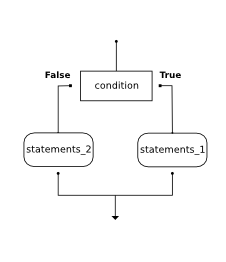Section 5.2 Conditional Execution: Binary Selection
In order to write useful programs, we almost always need the ability to check conditions and change the behavior of the program accordingly.
Branching statements, sometimes also referred to as
conditional statements or
Selection statements, give us this ability. The simplest form of branching is the
if statement. This is sometimes referred to as
binary selection since there are two possible paths of execution.
The syntax for an
if statement looks like this:
if BOOLEAN EXPRESSION:
STATEMENTS_1 # executed if condition evaluates to True
else:
STATEMENTS_2 # executed if condition evaluates to False
The boolean expression after the
if statement is called the
condition. If it is true, then the immediately following indented statements get executed. If not, then the statements indented under the
else clause get executed.
The
if statement consists of a header line and a body. The header line begins with the keyword
if followed by a
boolean expression and ends with a colon (:).
The more indented statements that follow are called a
block. We will see this construction repeated several times in the future. Indent is
4 spaces in Python and must be same for each line. In your Python interpreter, you can easily indent lines using the tab key on your keyboard.
As a program executes, the interpreter always keeps track of which statement is about to be executed. We call this the control flow, or the flow of execution of the program. When humans execute programs, they often use their finger to point to each statement in turn. So you could think of control flow as "Python’s moving finger".
Control flow until now has been strictly top to bottom, one statement at a time. We call this type of control
sequential. In Python, flow is sequential as long as successive statements are indented the
same amount. The
if statement introduces indented sub-statements after the if heading.
Back to the example, each of the statements inside the first block of statements is executed in order if the boolean expression evaluates to
True. The entire first block of statements is skipped if the boolean expression evaluates to
False, and instead all the statements under the
else clause are executed.
There is no limit on the number of statements that can appear under the two clauses of an
if statement, but there has to be at least one statement in each block.
Each compound statement includes a heading and all the following further-indented statements in the block after the heading. The
if -
else statement is an unusual compound statement because it has more than one part at the same level of indentation as the
if heading, (the
else clause, with its own indented block).
Checkpoint 5.2.1.
How many statements can appear in each block (the if and the else) in a conditional statement?
Checkpoint 5.2.2.
What does the following code print (choose from output a, b, c or nothing)?
if 4 + 5 == 10:
print("TRUE")
else:
print("FALSE")
Checkpoint 5.2.3.
What does the following code print?
if 4 + 5 == 10:
print("TRUE")
else:
print("FALSE")
print("TRUE")
a. TRUE
b.
TRUE
FALSE
c.
FALSE
TRUE
d.
TRUE
FALSE
TRUE
Output a
- Although TRUE is printed after the if-else statement completes, both blocks within the if-else statement print something too. In this case, Python would have had to have skipped both blocks in the if-else statement, which it never would do.
Output b
- Because there is a TRUE printed after the if-else statement ends, Python will always print TRUE as the last statement.
Output c
- Python will print FALSE from within the else-block (because 5+4 does not equal 10), and then print TRUE after the if-else statement completes.
Output d
- To print these three lines, Python would have to execute both blocks in the if-else statement, which it can never do.
You have attempted
of
activities on this page.

